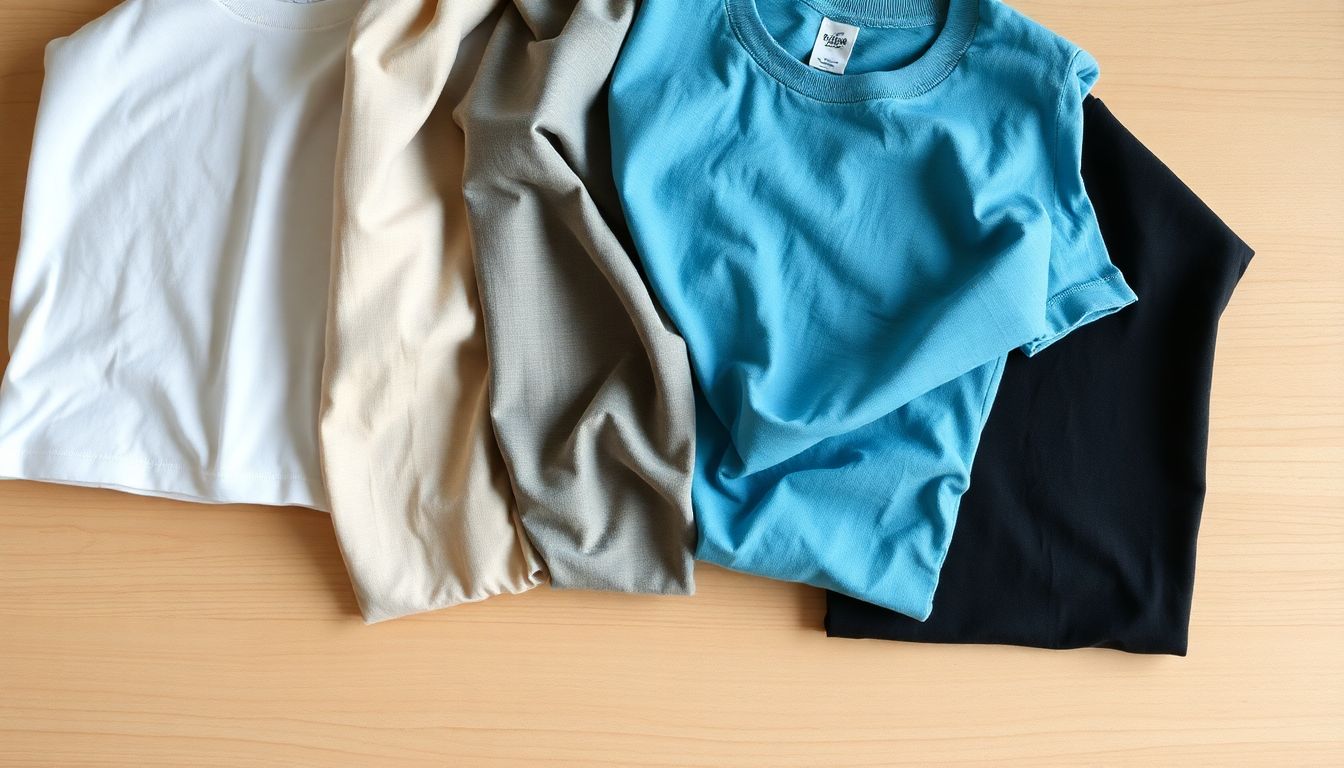A Guide to Different Types of T-Shirt Fabrics for Printing

Understanding T-Shirt Fabric Composition: The Basics
Natural Fibers: Cotton, Linen, Hemp
Natural fibers are known for their comfort and breathable nature.
- Cotton is the most common fabric. It’s soft, absorbent, and great for print quality, but it can shrink.
- Linen offers excellent breathability but wrinkles easily.
- Hemp is durable and eco-friendly but may feel rougher compared to cotton.
Pros and Cons:
- Cotton: Great ink absorption, but can shrink.
- Linen: Breathable but might not print as well.
- Hemp: Strong and sustainable, but less soft.
Brands like Bella + Canvas and American Apparel often use cotton for its softness and quality.
Synthetic Fibers: Polyester, Rayon, Nylon
Synthetic fabrics offer different advantages.
- Polyester is strong, wrinkle resistant, and wicks moisture but may not absorb ink as well as cotton.
- Rayon feels silky and drapes well, but it’s less durable.
- Nylon is tough and stretchable but can be slippery for printing.
Characteristics:
- Polyester: Durable but can lead to fading in prints.
- Rayon: Soft and drapes well; however, it can shrink.
- Nylon: Strong yet requires careful ink selection.
Brands like Under Armour and Nike often use these materials for athletic wear due to their durability.
Fabric Blends: Combining Natural and Synthetic Fibers
Blending fibers combines the strengths of each material.
- Cotton-polyester blends offer great softness and durability while maintaining good print quality.
- Tri-blends (cotton, polyester, and rayon) are soft and have a vintage feel.
Benefits:
- Improved durability from synthetics mixed with natural softness.
- Enhanced printability and a comfortable fit.
Popular fabric blends include Next Level’s Tri-Blend Tees, known for their amazing softness and visual appeal.
Fabric Weight and GSM: Its Impact on Print Quality
Understanding GSM (Grams per Square Meter)
GSM measures fabric weight. It’s vital for determining the right fabric.
- Lightweight t-shirts: around 130-150 GSM.
- Midweight t-shirts: 150-180 GSM.
- Heavyweight t-shirts: 180-220 GSM.
Heavier fabrics tend to offer more durability, while lighter ones provide breathability.
How GSM Affects Print Results
GSM plays a significant role in print quality.
- Higher GSM allows for better ink absorption, resulting in vibrant prints.
- Lower GSM fabrics might cause the design to bleed or look less vivid.
Choosing the right GSM based on your design can enhance the final product. For example, detailed designs work better on heavier materials.
Real-world Examples of GSM in Action
T-shirts with 160 GSM may have a different drape than those at 200 GSM. Numerous brands highlight these differences, making it easy to see how fabric weight impacts print quality.
Popular T-Shirt Fabrics for Different Printing Methods
Screen Printing: Best Fabric Choices
Screen printing works well with specific fabrics.
- 100% cotton is ideal for vibrant prints.
- Cotton blends offer versatility.
These fabrics maintain good ink adhesion and offer excellent results. To achieve optimal prints, use thicker inks on these materials.
DTG (Direct-to-Garment) Printing: Fabric Considerations
Direct-to-garment printing shines with the right fabrics.
- 100% cotton and cotton-polyester blends are preferred.
- Fabrics like 100% polyester can pose challenges.
Pre-treating cotton fabrics helps ink stick better, enhancing the final appearance.
Sublimation Printing: Suitable Fabrics
Sublimation technology requires specific fabrics.
- 100% polyester or polyester blends work best.
- The fabric must be white or light to ensure vibrant colors.
Choosing polyester ensures designs are long-lasting and vibrant.
Fabric Care and Print Longevity
Washing and Drying Recommendations for Printed T-shirts
To maintain print quality, proper care is essential.
- Wash printed t-shirts inside out using cold water.
- Avoid tumble drying; air drying preserves print quality.
Different printing methods may require unique care, so refer to specific guidelines to prevent fading.
Fabric Treatment for Enhanced Durability
Pre-treating fabrics can boost longevity.
- Softeners improve the feel but may hinder print adhesion.
- Avoid harsh chemicals that might damage prints.
Caution is key when selecting fabric treatments to maintain quality.
Impact of Fabric Choice on Print Lifespan
The fabric type significantly influences print durability.
- Studies show cotton prints can last three times longer when treated properly.
- Different blends can enhance or reduce print lifespans.
Experts emphasize the importance of fabric selection for lasting impressions.
Choosing the Right Fabric for Your Project: A Practical Guide
Understanding Your Design and Printing Method
Match the fabric to your design for the best results.
- Consider the aesthetic and feel of your print.
- A checklist may help determine the best fabric for your needs.
Successful brands have built their identities on fabric selection.
Budget and Production Scale Considerations
Consider costs when selecting fabrics.
- Premium fabrics may yield better final products.
- Economical options are available without sacrificing quality.
Understanding fabric implications can help in planning production timelines.
Sourcing High-Quality T-Shirt Fabrics
Find reliable sources for quality fabrics.
- Reputable suppliers ensure consistent quality.
- Check samples before making bulk purchases.
Negotiating prices wisely can lead to better deals.
Conclusion:
Choosing the right t-shirt fabric is vital for quality prints. The impact of fabric on durability, design, and overall experience cannot be understated. Share your experiences or questions below and engage with the community in your journey to crafting the perfect tee!
Comments
Post a Comment